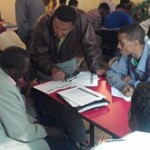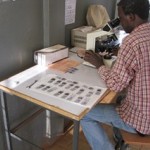
Accurately quantifying antimalarial commodity requirements in Ethiopia is a challenge for multiple reasons. Transmission of malaria is highly variable and characterized by frequent and often large-scale epidemics. In addition, both artemisinin-based combination therapy (ACT) and rapid diagnostic tests (RDTs) have a short shelf life.

PMI/Ethiopia, in close collaboration with the Federal Ministry of Health, the Ethiopian Health Nutrition Research Institute, and the Oromia Regional Health Bureau, has been implementing malaria laboratory diagnosis and monitoring activities for the last three years. This has included developing guidelines and training materials for malaria laboratory diagnosis, training clinical and laboratory health professionals in malaria laboratory diagnosis, and supporting quality assurance/quality control systems.
In October 2012, a dozen ONE Moms visited Ethiopia. During their visit, the moms visited many sites including farms, schools and health clinics sponsored by a number of governmental, international and non profit organizations that are having a transformational impact on the lives of women, their families and their communities.
Most Americans have plenty of water to drink, bathe and flush the toilet, wash clothes and cars, water the lawn and fill the community pool. Even when tap water is safe to drink we often buy bottled water. Competition for oil, alternatives to fossil fuel, and the price of gasoline may be foremost on our mind. But competition for water may in fact be a greater challenge in the 21st century. As developing nations turn to hydro and solar power to fuel their energy and electric power needs, water will be the “new oil” for many nations around the world.
With the click of a mouse, the final versions of maps outlining conservation areas have set the precedent for a new kind of land management in Ethiopia. The maps show authorized land use for six Community Conservation Areas (CCAs) in Ethiopia’s Central and Southern Rift Valley— the first such areas to be officially recognized by the state. The final keystroke capped more than five years of work by the Ethiopian Sustainable Tourism Alliance, a U.S. Agency for International Development-supported program implemented by Counterpart International. The alliance aims to enhance biodiversity conservation and economic development through sustainable tourism, community mobilization and improved livelihoods throughout the region.








Comment
Make a general inquiry or suggest an improvement.